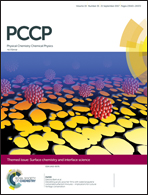Spatial separation of the hydrogen evolution center from semiconductors using a freestanding silica-sphere-supported Pt composite†
Abstract
Spatial separation of the reduction center (photosystem I) and oxidation center (photosystem II) is an obvious characteristic of natural photosynthesis. Enlightened by this natural process, a simple material based on silica-sphere-supported Pt nanoparticles (SSP) was designed as a freestanding hydrogen evolution center for semiconductor photocatalysts. In situ photoluminescence characterization showed that the radiation recombination of electron–hole pairs in semiconductors (i.e. TiO2 and CdS) was well suppressed due to the presence of SSP. And the quenching efficiency increases with the hydrogen evolution rate of photocatalysts. These results indicated that SSP could effectively trap electrons from the photoexcited semiconductors during collision between SSP and semiconductor, and then complete the hydrogen evolution reaction over the Pt nanoparticles. Detailed investigation also showed that the performance of SSP was influenced by several factors, including the particle size of the silica sphere and the physical and chemical states of Pt nanoparticles. Besides, it was demonstrated that the loaded metal was not limited to Pt. Pd, Ni and Au can also be used as active sites in this freestanding cocatalyst strategy.



 Please wait while we load your content...
Please wait while we load your content...